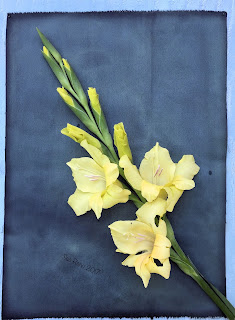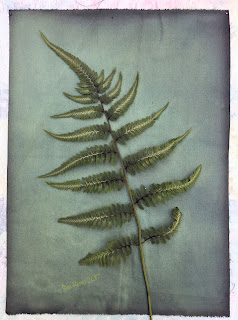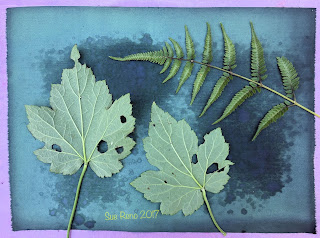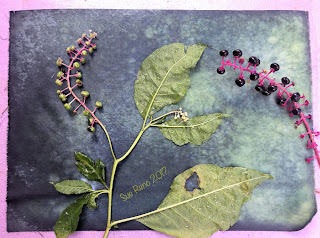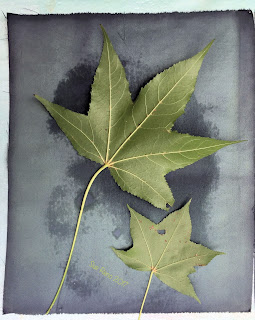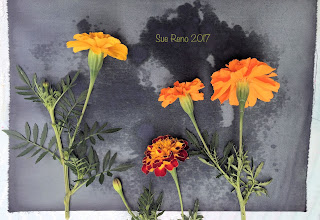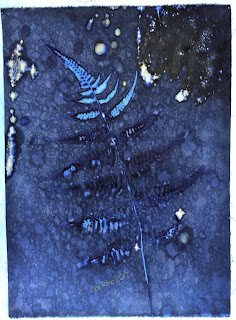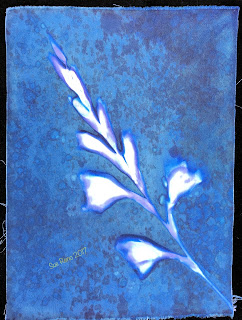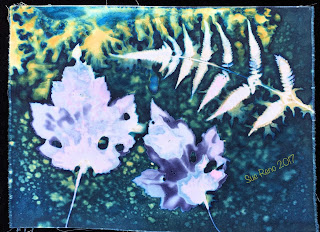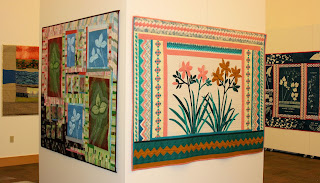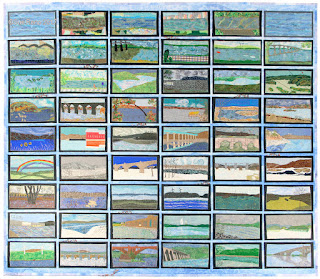Here is a delicate painted fern frond. This and the gladiola were done with just water, on cotton sateen.
The days were warm, but the there were many less hours of sunshine then when I started this experiment in June, and I noticed I was not getting as much of a color shift. So for the rest of these I added a spritz of diluted washing soda around the edges to push the process a bit. Those are two Japanese anemone leaves with a fern, above. I also added a spritz of diluted red textile paint to most of these.
Poke, Phitolacca americana, is one of my favorite wild plants to admire as I assiduously weed it out of my gardens. The birds love the berries and spread them all about. I also love the berries--used to make "ink" with them as a child--and was curious to see what would happen with them in a wet cyanotype print. They have a lot of color, but it's a "fugitive" dye that's generally not permanent.
Here's Poke Salad, the art quilt with the very first cyanotype print I ever made. I was immediately addicted to the process:
 |
| Poke Salad, by Sue Reno |
And here's Sweetgum in Autumn. I've been working with the plants in my environment for a long time, and I discover a new perspective every time I take a fresh look.
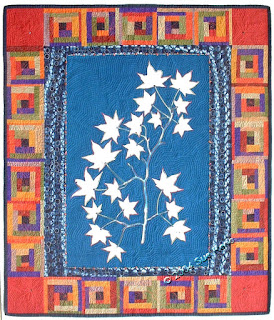 |
| Sweetgum in Autumn, by Sue Reno |
Here are the prints after roughly 24 hours exposure, before being rinsed out. I love them at this stage, partly because it's so transitory. The glad is looking good.
This painted fern print is very delicate and tenuous at this stage.
But the same type of fern is much more assertive here:
The ripe poke berries bled out their color and were quite brilliant in the first hour or so of the exposure, then the color cooked out and mostly faded. Still, a cool aurora effect happened:
There's a lot going on with these sweetgum leaves:
Flowers are the trickiest things to print with this process so far in my experience, but I am heartened at the first look at these marigolds:
And here are the rinsed, finished prints. The gladiola print is quite good:
This fern is still tenuous, but has a lot of potential for stitch work:
I'm kind of crazy about this one:
I'm a bit ambivalent about this:
With a little definition of the edges with stitching, this will be spectacular:
And I love the halo effect the blossoms made as they shrank up in the sun.
So all in all, a good finish to my summer of wet cyanotype printmaking! I am already doing the preliminary work on using many of these in more art quilts, which is my ultimate goal in making them. I have very much enjoyed the process of documenting my experiments here on my blog, and really appreciate all the lovely feedback I've received. You can review all 12 posts in reverse chronological order by clicking the Wet Cyanotype tab in the top header, or click here.
And a reminder that I also post on social media:
Facebook page:http://www.facebook.com/suerenostudio
Twitter feed: http://twitter.com/suereno
Tumblr: http://suerenostudio.tumblr.com
Instagram: https://www.instagram.com/sue_reno_studio/
